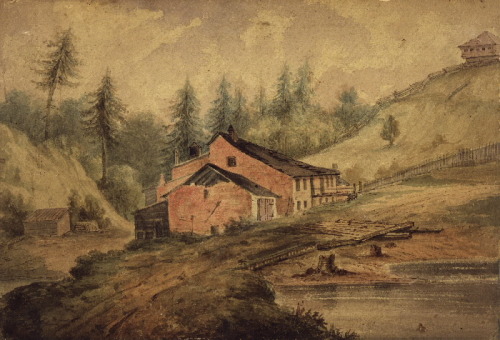Reposted from TRCA’s Discover the Don blog.

During the 19th century, there were a few creeks in Toronto that were known as “Brewery Creek” due to the breweries that could be found along their waters. Two such creeks were Castle Frank Brook and Taddle Creek.
Castle Frank Brook
Castle Frank Brook, now a buried creek, once emerged from small tributaries that formed near Lawrence and Dufferin and flowed southeast before joining the Don River south of Prince Edward Viaduct. Although most of Castle Frank Brook is now contained by sewers, you can still see remnants of the dramatic stream valley and topographic influence it left on the city’s landscape, most notably Cedarvale Ravine, Nordheimer Ravine and Rosedale Valley.
Along its course, Castle Frank Brook passed under Yonge Street and ran alongside two breweries: Bloor Brewery and Yorkville Brewery.
Bloor Brewery was built in 1830 and run by Joseph Bloore, the namesake of Bloor Street. The brewery was located in the Rosedale Valley Ravine between Mount Pleasant Road and Sherbourne Street on the south side of Castle Frank Brook.
With no surrounding businesses or residents, Bloore was able to alter the creek to benefit the operations of his brewery. By constructing a dam just above the brewery, Bloore was able to create a sizeable mill pond from which water could be channeled into his brewery using a 200-foot sluice. The pond also served as a popular local swimming hole in the summer and skating rink in the winter. The setback to his location was that the creek wasn’t wide enough to support the downstream shipment of his beer, so kegs had to be transported by land onto wagons via the steep ravine slopes.
In 1843, Bloor Brewery was bought by John Rose and renamed the Castle Frank Brewery. The brewery eventually closed in 1864 and the building was demolished in 1875.

Yorkville Brewery was a five-storey brewery and three-storey malt house established in 1835 on the east side of Yonge just north of Davenport. In addition to being called Brewery Creek, Castle Frank Brook was also referred to as Severn Creek, after John Severn the owner of Yorkville Brewery.
Dissatisfied with the local water quality for brewing, Severn had water transported from Summerhill via wooden pipes that ran along Yonge Street to his brewery.
After setting up breweries in California and Iowa, Severn returned to Toronto in 1863 and ran Yorkville Brewery until he passed away in 1880. His son George inherited the company, which eventually closed a few years later for financial reasons.
While there’s no remaining trace of the brewery, Severn’s legacy can be seen on the Yorkville coat of arms, which featu



Taddle Creek
Taddle Creek is another buried stream, which formed from a creek-fed pond at Wychwood Park and flowed southeast off Bathurst, cutting across University of Toronto before emptying into Lake Ontario near Parliament St. Taddle Creek also went by the names Little Don River, Goodwin Creek, University Creek, Wolz Creek, and in the segment close to Enoch Turner’s Brewery, Brewery Creek. Today, very little of the creek remains, but evidence of its winding course can be seen when walking down Philosopher’s Walk on the University of Toronto’s campus.
Enoch Turner’s Brewery opened in 1831 along Taddle Creek at the southeast corner of Front and Parliament near the mouth of the creek. After being in operation for one year, the brewery was devastated by fire and Turner was left without the funds to rebuild.

Through the charity of neighbouring businesses, including a benefit performance by the Toronto Circus, Turner was able to construct a new distillery and brewery on the old site. The distillery was erected in 1841 and the main building of the brewery was up by the mid-1840s. According to the Globe, the new building was an impressive structure, having “every convenience for brewing and distilling on a very extensive scale.” In 1854, Turner retired and sold the brewery.
Enoch Turner is probably best known for the Enoch Turner Schoolhouse built in 1848, which was Toronto first free school. The school can still be found at its original location on Trinity St. between King St E. and Eastern Ave.
The Don River and its tributaries have a long history as a water source and transportation route, which is why so many early industries in Toronto were based close to its waters. These industries included mills, brickmaking factories, tanning factories and distilleries. This concentration of industries over time would eventually lead to the environmental degradation of the river. It was only after the reform of industrial practices and cleanup efforts by various groups over the course of several years that we’ve seen the landscape of the Don River slowly recover and regenerate.
Interested in how they brewed beer in the mid-1800s? Check out the Black Creek Pioneer Village Historic Brewery to learn about the techniques, tools and recipes used by brewers in 1860s Ontario!
